The AMD 2nd Gen Ryzen Deep Dive: The 2700X, 2700, 2600X, and 2600 Tested
by Ian Cutress on April 19, 2018 9:00 AM ESTConclusion: Catching the Incumbent
Throughout AMD’s journey with Zen, the goal of high-performance x86 compute has two goals: be competitive, and be the best. Without a doubt the first generation of Ryzen certainly succeeded in being competitive, with analysts and outlets showing Ryzen processors in top selling lists, and review benchmarks putting the top AMD chips competitively against Intel’s high-end desktop parts. The goal, for the next few years, is to grab that low hanging microarchitectural fruit, and to taking advantage of new process nodes as time goes on. First stage is Ryzen’s second generation, known as the Ryzen-2000 series.
In this review we’ve shown that AMD met its goal of an additional 3% raw performance gain, with our benchmarks showing +3.1%. Combining this with the frequency increases derived from the GlobalFoundries 12nm manufacturing process, and turbo features such as Precision Turbo Boost making the most of thermal limits in an intuitive way, AMD also hit its 10% performance gain between generations. This doesn’t sound like much in all honesty, as on the surface this seems little more than an improved manufacturing bump plus some intelligent reduction in cache latency – if this was Intel, we’d be crying out for a big and brash gain in performance, but AMD is still riding the Zen design train and the focus is on the next full microarchitectural update in Zen 2, so most users and journalists are giving AMD a certifiable thumbs up at this point hoping to see a bigger jump next time around.
4K Gaming Analysis
However, everyone wants to know about the Ryzen 2000-series results. We start with gaming, and first up in our Performance/Price graphs is the high-end 4K gaming results. Our results take the R7 1800X as the base ‘100%’ and we take the geometric mean over all of our gaming tests at 4K.
Across the board, the new Ryzen 2000-series processors improved over the Ryzen 7 1800X, even the Ryzen 5 2600, from 1-3%. The Intel processors were 0-4% ahead of the 1800X, with both Coffee Lake processors being at that top 4%. In a GPU limited scenario here, there is some benefit to that single core performance for sure, however all the modern CPUs at a reasonable frequency seem plenty to get through.
For 99th percentile graphs, the new AMD processors either draw level or narrowly beat the Ryzen 1000-series. For our Intel tests, the 6700K/7700K previous generations are both down 3% over the 1800X, but the others are up 4% over the 1800X. Intel pushing Coffee Lake has helped it get that top spot, but all the processors (except Bristol Ridge, the A12-9800) perform pretty much equal again.
1080p Gaming Analysis
The key aspect for some users is in the lower resolution gaming: 1920x1080 is still the resolution that dominates the gaming charts, no matter how much us enthusiasts like to push for more pixels. Some readers reached out to us stating that they still buy the best graphics card but run at 200+ FPS at low resolutions, just for responsiveness. Running at lower resolution is a poor indication of future CPU performance, but what matters is the real world numbers that we are seeing today.
At this resolution, the Ryzen 7 2700X pushes an average +7% over the previous generation 1800X, and the new 65W parts easily matching the 1800X as well. Users who were looking at the budget friendly Ryzen 5 1600, the best seller for AMD last year according to some reports, can now look at the 2600 for +7% or 2600X for a +10% gain over the 1600.
However, Intel pulls out a win here. Through the higher IPC and clock speed, the Coffee Lake processors are 8-10% over Ryzen 7 2700X, ranging from +3% to +25% depending on the title. By contrast, our results do show that the Ryzen 7 2700X blasts past the older Intel generation processors, maing the 2700X win by a small margin to Kaby Lake and a 5%+ margin to Skylake.
The 99th percentile graph at 1080p looks like a stretched out version of the average frame rate graph, and this is broadly accurate: the processors better at 1080p perform even better on percentiles. Out of all the metrics AMD needs to be competitive on, this is the one where the new performance boost works best, but there is still work to do. This will, in all honesty, look better if and when AMD can match Intel on frequency. AMD also has a deficit in main memory DRAM latency, which we have cited as a factor in previous testing for 99th percentile frame rates. It will be interesting if AMD pushes ahead with a higher supported memory frequency quicker than Intel, because that would help here.
Workstation Analysis
For mainstream processor lines, with Ryzen-1000, AMD put eight cores and sixteen threads against Intel’s Kaby Lake with four cores and eight threads. This time around Intel has moved up to six cores with Coffee Lake, making it 12 on Intel vs. 16 on AMD, and pumped some more turbo frequency as well, but Intel is pushing the power budget beyond the box rating by a considerable margin by comparison. In the mid-range, where it was four threads against twelve, it is now six against twelve, however again Intel hits the higher frequencies.
In our single threaded benchmarks, the new Ryzen-2000 series now does match Intel’s Skylake processors for performance. In the last round of comparisons, Intel still had some advantage, but now the two are equal. Unfortunately for AMD, Intel is two further ‘generations’ ahead, through Kaby Lake and Coffee Lake, which mainly add in single core performance through additional frequency. This means that a Core i5-8400 does beat the best AMD has in single thread, and the Core i7-8770K rules the roost.
In multi-threaded workloads, a number of additional variables come into play. The nature of the threading in each core, such as which parts of the core are dynamic or statically partitioned, come into play, along with how memory and cache are managed. Here AMD has been aggressive in low level cache latency and size, however the AMD L3 non-inclusive cache is transposed against Intel’s L3 write-back cache which is more useful, as well as lower latency main memory.
What we see here on the AMD side is that only the Ryzen 7 2700X eclipses the old Ryzen 7 1800X, with the 2700 close behind. In this price bracket, the higher thread count of the AMD chip gives it a healthy lead over the Coffee Lake i7-8700K, and it also eclipses the eight-core Skylake-X Core i7-7820X in most tests. What is very clear however is that the previous generation Intel parts, the i7-6700K and i7-7700K, sit very much behind the competition, and even behind AMD’s cheapest second generation Ryzen processor, the Ryzen 5 2600.
If someone had said a few years ago that AMD would design a second generation Ryzen processor in 2018 that would eclipse all of Intel’s Skylake and Kaby Lake processors, I would have laughed. But here we are, and it speaks to AMD’s execution. If a user wants a chip for a multi-threaded workload, the $199 Ryzen 5 2600 is the best budget performer on the market today.
In that mid-range price battle, the Ryzen 5 2600 also gives a swift kick to the Core i5-8400. It is a non-contest.
Overall Thoughts
You Win Some, You Lose Some, But Customers Win
When competition exists, each product needs to put its best foot forward. Tackling an incumbent is hard, with their existing relationships and high budgets, but forcing them to react is seen as a win for customers. A criticism levied at Intel in recent years is stagnation – minor process updates while waiting for a new process node; with so many eggs in the basket for future generation products, anything equally competitive can start to look attractive in the market. Those inside the industry can tell that while Intel is iterating on similar 14nm designs each year while waiting for 10nm to come to market, AMD is putting its best foot forward with Zen and Ryzen on 14nm, now with Ryzen 2 on GF 12nm.
Boiling down to simple recommendations this time around is actually going to be fairly easy.
Any users that would like high single threaded performance, or high performing 1080p gaming using a mid-range GPU, then Intel’s Core i5-8400 is going to fit the bill.
For hardcore enthusiasts, running high-end graphics at 4K or like getting their general compute on, the Ryzen 2000-series is looking the best choice. At each price point AMD can fit anyone’s 4K gaming needs and win in raw instruction throughput.
AMD also bundles a half-decent stock cooler in the box, something Intel has neglected in recent years, making the product even more attractive.


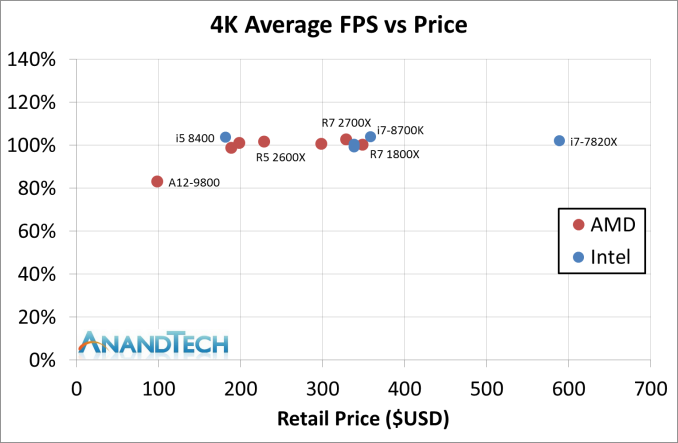
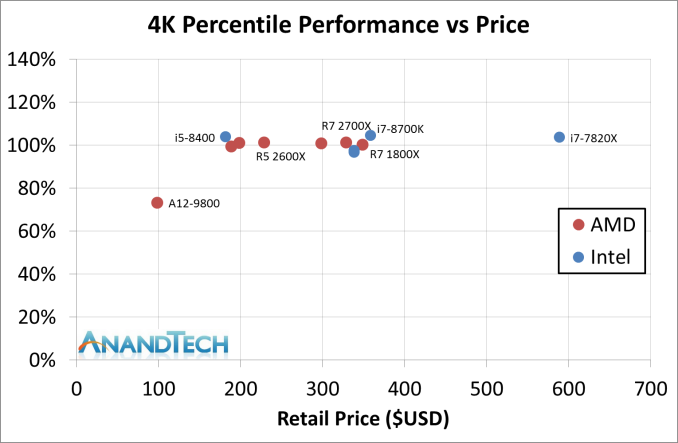
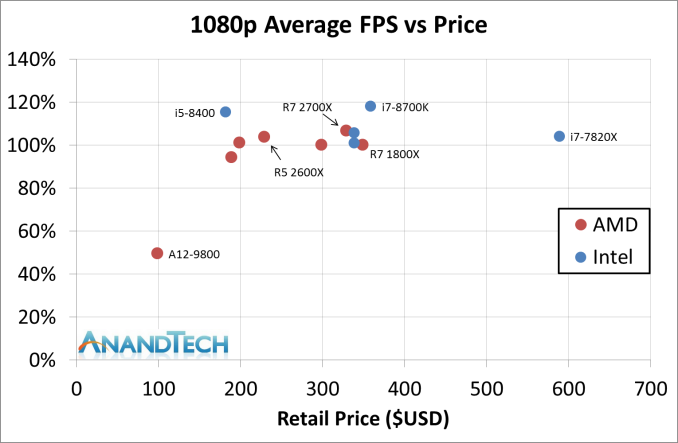
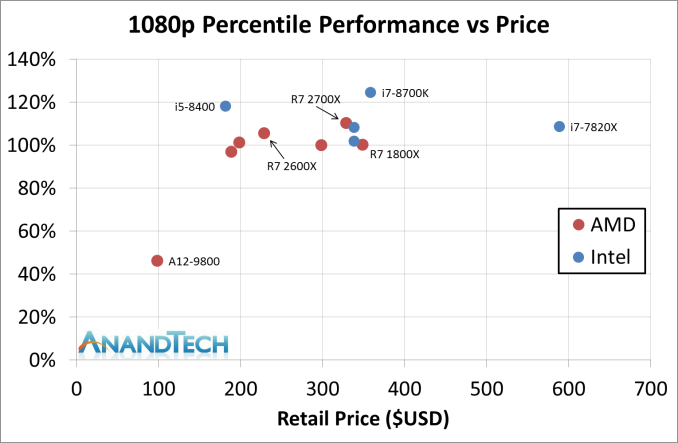
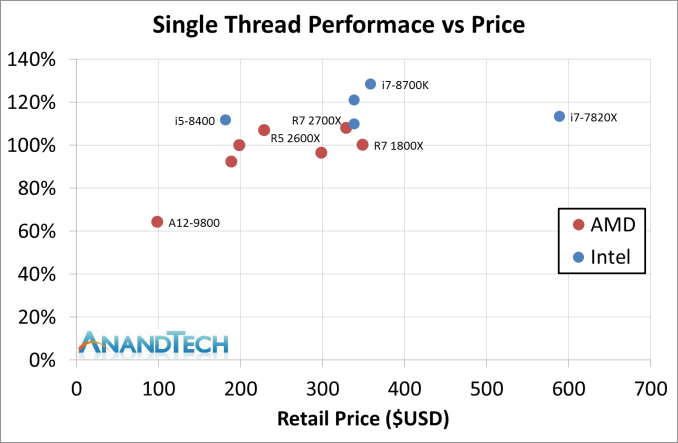
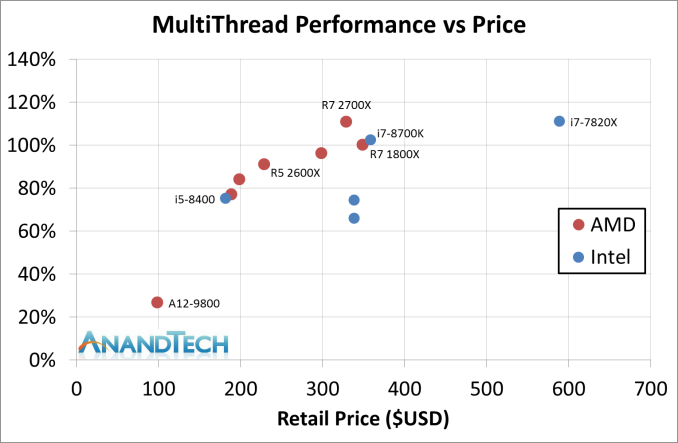








545 Comments
View All Comments
Marlin1975 - Thursday, April 19, 2018 - link
Looks good, guess AMD will replace my Intel system next.Just waiting for GPU and memory prices to fall.
3DoubleD - Thursday, April 19, 2018 - link
Agreed... the waiting continuesWorldWithoutMadness - Thursday, April 19, 2018 - link
Lol, you might even wait until Zen 2 comes out next year or even later.Dragonstongue - Thursday, April 26, 2018 - link
should be out next year as AMD has been very much on the ball with Ryzen launches more or less to the DAY they claimed would launch which is very nice...basically what they are promising for product delivery they are doing what they say IMO, not to mention TSMC recently announced volume production of their 7nm, so that likely means GloFo will be very soon to follow, and AMD can use TSMC just the same :)t.s - Tuesday, July 31, 2018 - link
What @WWM want to say is: You can wait forever for the RAM price to go down, rather than when ryzen 2 out.StevoLincolnite - Thursday, April 19, 2018 - link
I still haven't felt limited by my old 3930K yet.Can't wait to see what Zen 2 brings and how Intel counters that.
mapesdhs - Friday, April 20, 2018 - link
If you ever do fancy a bit more oomph in the meantime (and assuming IPC is less important than threaded performance, eg. HandBrake is more important than PDF loading), a decent temporary sideways step for X79 is a XEON E5-2697 v2 (IB-EP). An oc'd 3930K is quicker for single-threaded of course, but for multithreaded the XEON does very well, easily beating an oc'd 3930K, and the XEON has native PCIe 3.0 so no need to bother with the not entirely stable forced NVIDIA tool. See my results (for FireFox, set Page Style to No Style in the View menu):http://www.sgidepot.co.uk/misc/tests-jj.txt
mapesdhs - Monday, April 23, 2018 - link
Correction, I meant the 2680 v2.Samus - Friday, April 20, 2018 - link
I never felt limited by my i5-4670k either, especially mildly overclocked to 4.0GHz.Until I build a new PC around the same old components because the MSI Z97 motherboard (thanks MSI) failed (it was 4 years old but still...) so I picked up a new i3-8350k + ASRock Z270 at Microcenter bundled together for $200 a month ago, and it's a joke how much faster it is than my old i5.
First off, it's noticeably faster, at STOCK, than the max stable overclock I could get on my old i5. Granted I replaced the RAM too, but still 16GB, now PC4-2400 instead of PC3-2133. Doubt it makes a huge difference.
Where things are noticeably faster comes down to boot times, app launches and gaming. All of this is on the same Intel SSD730 480GB SATA3 I've had for years. I didn't even do a fresh install, I just dropped it in and let Windows 10 rebuild the HAL, and reactivated with my product key.
Even on paper, the 8th gen i3's are faster than previous gen i5's. The i3 stock is still faster than the 4th gen i5 mildly overclocked.
I wish I waited. It's compelling (although more expensive) to build an AMD Ryzen 2 now. It really wasn't before, but now that performance is slightly better and prices are slightly lower, it would be worth the gamble.
gglaw - Saturday, April 21, 2018 - link
i think there's something wrong with your old Haswell setup if the difference is that noticeable. I have every generation of Intel I7 or I5 except Coffee Lake running in 2 rooms attached to each other, and I can't even notice a significant difference from my SANDY 2600k system with a SATA 850 Evo Pro sitting literally right next to my Kaby I7 with a 960 EVO NVMe SSD. I want to convince myself how much better the newer one is, but it just isn't. And this is 5 generations apart for the CPU's/mobos and using one of the fastest SSD's ever made compared to a SATA drive, although about the fastest SATA drive there is. Coffee Lake is faster than Kaby but so tiny between the equivalent I7 to I7, I can't see myself noticing a major difference.In the same room across from these 2 is my first Ryzen build, the 1800X also with an 960 EVO SSD. Again, I can barely convince myself it's a different system than the Sandy 2600k with SATA SSD. I have your exact Haswell I5 too, and it feels fast as hell still. Especially for app launches and gaming. The only time I notice major differences between these systems is when I'm encoding videos or running synthetic benchmarks. Just for the thrill of a new flagship release I just ordered the 2700X too and it'll be sitting next to the 1800X for another side by side experience. It'll be fun to setup but I'm pretty convinced I won't be able to tell the 2 systems apart when not benchmarking.